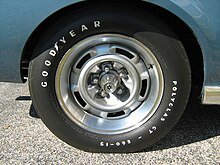
The Goodyear Polyglas tire was a bias-belted tire announced in 1967 by Goodyear. "Polyglas" was a registered trademark.[2] The tire combined some characteristics of both bias-ply and radial-ply tires. They had a wider tread than most other tires on the market then and used fiberglass belts.
Design
[edit]Conventional tires up to that time featured a bias or cross-ply construction with body cords extending diagonally from bead to bead. The Polyglas tires had a bias construction that added stabilizing circumference belts directly beneath the tread. These fiberglass belts surrounded the polyester cord body, thus the Polyglas name for which Goodyear registered a U.S. trademark #859,703.[3] The construction was a type "domestic performance car fans were familiar with".[3]
Goodyear promoted the fiberglass belt design as having less tread "squirm" as the tire rolls on the road surface and improved traction for acceleration and braking.[3] The polyester sidewalls provided stability for heavy cars at low inflation pressures. The features increased the mileage and enhanced road-holding performance. The objective was to gain the radial tire's longer tread life and a firmer road grip in a bias-belted tire.[3] The Polyglas tires featured a wide footprint.[4]
Application
[edit]
Goodyear Poluglas tires were available as standard equipment in the late 1960s and early 1970s muscle cars from General Motors, Ford, Chrysler, and American Motors.[5] There were also comparable tires from competitors such as the Firestone Sup-R-Belt Wide Oval and Atlas Plycron 2plus2.[6][7] Goodyear and comparable bias-belted tires began appearing as standard or optional equipment on most 1969-model passenger cars[4] and nearly all 1970 through 1974 models.
The most common version of the Polyglas on muscle cars of that era with raised white lettering.[8] This was one of the first commercially available raised white-lettered tires on the market. Some high-performance cars also featured narrow "redline" sidewalls as standard equipment.[9] Other versions of the Polyglas lineup were offered as blackwall, whitewall, and snow treaded tires.[10] For driving in winter, Polyglass Pathfinder line of tires were available in unique versions for the steering front and rear driving axles along with optional "Safety Spikes" (studs).[11]
Advertising
[edit]The tires were marketed for their longer life as well as in situations where better tires are needed to compensate for the driver and challenging conditions.[12] Television advertisements in 1970 showed that women need Polyglas tires to compensate for their lack of driving ability.[13]
Successors
[edit]Automakers and consumers in the United States continued with low-cost bias-ply type tires through the early 1970s.[14] The Polyglas tire and its combination competitors were replaced by steel belted radials as original equipment tires after 1975. Increased fuel efficiency and tire mileage overcame the higher price of radial construction. According to a 1976 study, more police departments used steel or fabric radial-ply tires than belted bias-ply and bias or cross-ply tires for their pursuit cars.[15]
Goodyear Polyglas tires are now manufactured for owners of period cars.[16]
Notes
[edit]- ^ Cranswick, Marc (2011). The Cars of American Motors: An Illustrated History. McFarland. p. 103. ISBN 9780786446728. Retrieved 19 May 2024 – via Google Books.
- ^ "Buy Goodyear Polyglas for mileage (advertisement)". Life. Vol. 68, no. 16. 1 May 1970. pp. 58–59. Retrieved 19 May 2024 – via Google Books.
- ^ a b c d Cranswick, Marc (2016). Ford Midsize Muscle - Fairlane, Torino & Ranchero. Veloce. p. 90. ISBN 9781845849290. Retrieved 20 May 2024 – via Google Books.
- ^ a b "Our Company History 1960-1979 (1967 Custom Wide Tread Polyglas Announced)". Goodyear Tire & Rubber. Retrieved 19 May 2024.
- ^ Herd, Paul A. (1997). Challenger and Barracuda Restoration Guide, 1967-74. MotorBooks International. p. 123. ISBN 9781610608473. Retrieved 20 May 2024 – via Google Books.
- ^ "Firestone announces new Sup-R-Belt. Twice the tire- twice the mileage". Popular Mechanics. Vol. 131, no. 92. March 1969. p. 92G. Retrieved 20 May 2024 – via Google Books.
- ^ "Tormented (advertisement)". Popular Science. Vol. 197, no. 1. July 1970. p. 25. Retrieved 20 May 2024 – via Google Books.
- ^ Donahue, Greg; Zazarine, Paul (1990). How To Restore Your Muscle Car. Motorbooks. p. 191. ISBN 9781610590327. Retrieved 20 May 2024 – via Google Books.
- ^ "1969 Hurst SC Rambler foldout (side B)". oldcarbrochures.org. Retrieved 19 May 2024.
- ^ "Goodyear announces the first Polyglas winter tire". Life. Vol. 65, no. 20. 15 November 1968. p. 113. Retrieved 19 May 2024 – via Google Books.
- ^ "Goodyear four-wheel control (advertisement)". Life. Vol. 69, no. 21. 20 November 1970. pp. 26–27. Retrieved 19 May 2024 – via Google Books.
- ^ Hudson, Travis (5 July 2008). "Goodyear Polyglas Tires Help Stereotypical Women Drivers". Jalopnik. Retrieved 19 May 2024.
- ^ Van Hoven, Matt (29 December 2009). "Daily Misogyny: Goodyear's Polyglas Will Save Your Wife". AdWeek. Retrieved 19 May 2024.
- ^ Skrabec, Quentin R. (2014). Rubber: An American Industrial History. McFarland. p. 206. ISBN 9780786469987. Retrieved 19 May 2024 – via Google Books.
- ^ Lewis, Alvin C.; Lewis, Jr., Ernest (1979). "Guide to High Speed Patrol Car Tires". National Bureau of Standards. pp. 4–5. Retrieved 19 May 2024.
- ^ Scott, Jason (1999). How to Rebuild and Modify Your Muscle Car. Motorbooks. p. 132. ISBN 9781610590181. Retrieved 20 May 2024 – via Google Books.